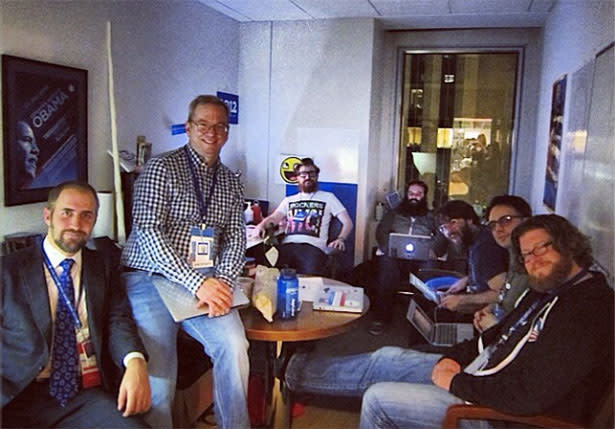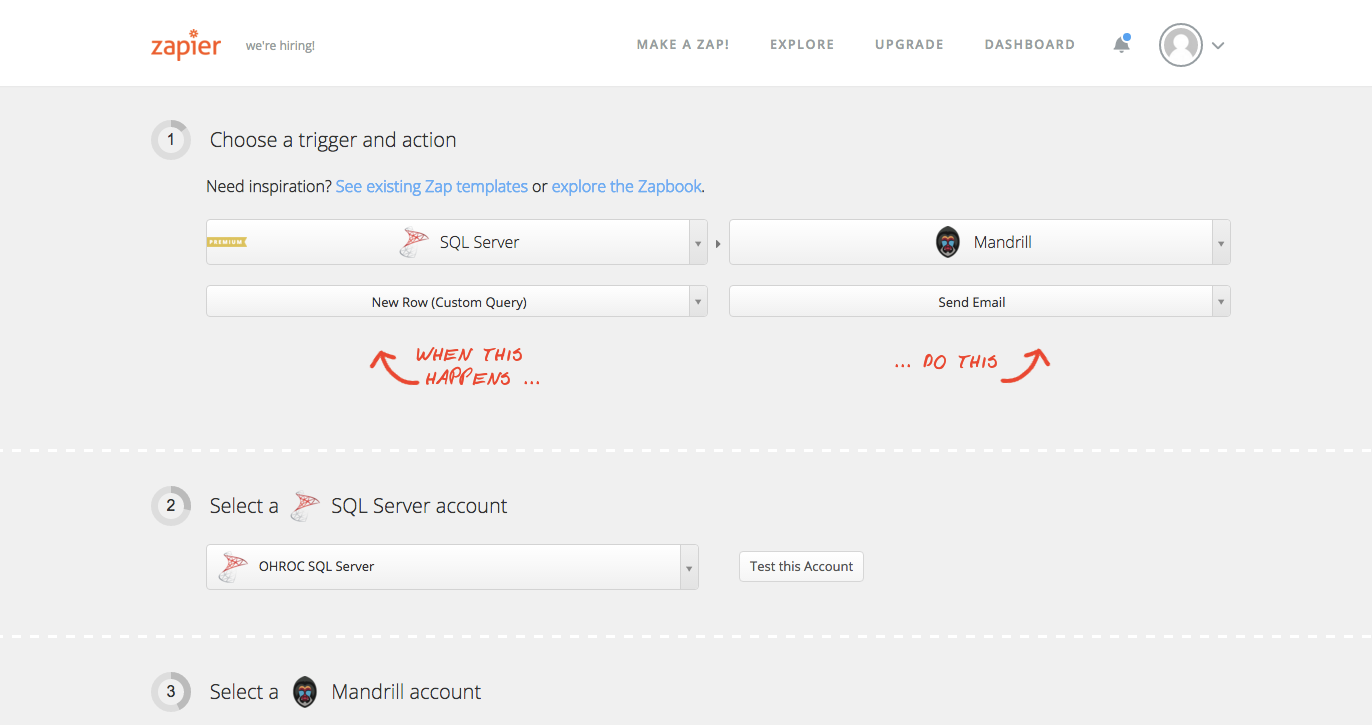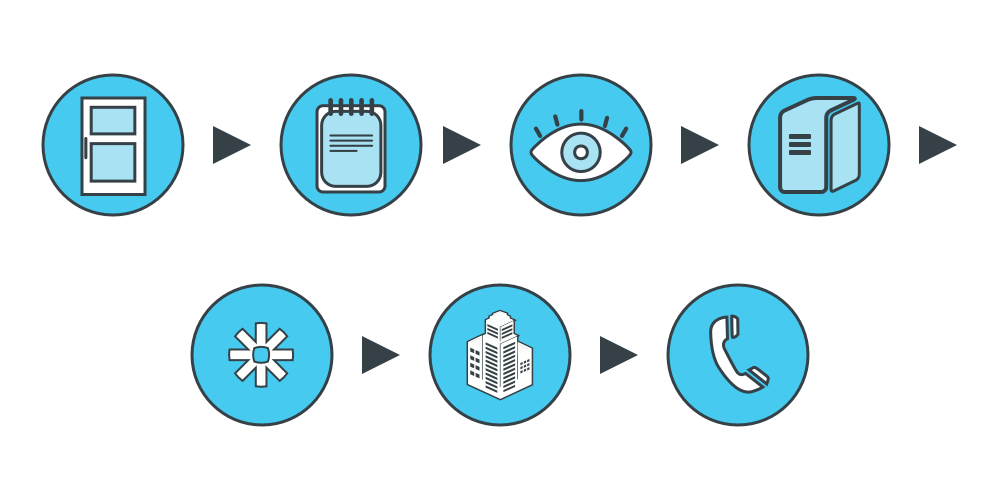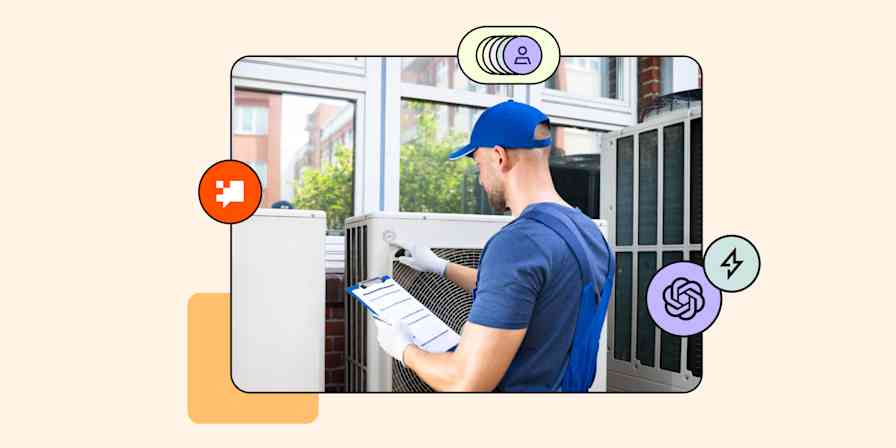It's May 6, 2014. Election day is six months away, and the Ohio House Republican Organizational Committee is betting on 25-year-old Vasyl Rabosyuk. No, he's not an up-and-coming political powerhouse, or a can't-lose campaign manager. He's their director of technology development, hired to solve one perennial campaign problem: dispersed data.
"There's voter data everywhere," Rabosyuk says. "A lot of times it's not collected, and even when it is collected, it sits and dies in an Excel spreadsheet without being useful."
That voter data—like names, addresses, and phone numbers—is stored in digital "silos." And the silos aren't connected, which makes it nearly impossible to find what you're looking for. So Rabosyuk put himself and three teammates on a mission to connect those silos, making the data more accessible and easier to use going forward.
Here's the kicker: they needed to connect these silos fast—very fast. In two months, canvassers would hit the streets, talking with voters and stuffing those silos with more mismatched data.
Time is an obstacle. So are money and manpower—the Ohio House Republican Organizational Committee (OHROC) has neither the funds to pay for an outside tech consultant nor the time to build an internal tech team.
Rabosyuk needs a solution; he needs it last week. And with no development skills to speak of, he'll need to get creative.
But we probably wouldn't be telling you this story if he came up short, right?
Rabosyuk built a system that worked so well, he credits it with helping OHROC break a historic political campaign record. Their goal is to fill the Ohio House of Representatives with their Republican candidates. In 2014, they exceeded expectations, bumping the party's supermajority from 60 to 65 of the 99 available seats.
That's the largest majority held by either party in the state since 1967.
This is the story of how Rabosyuk helped OHROC solve their data dilemma, and a look at how technology plays an increasingly important part in political campaigns.
Nerds and Politics

In an article from The Atlantic titled "The Nerds Go Marching In," Alexis Madrigal celebrates the software engineers that helped Obama win a close presidential campaign in 2012. Thanks to his prodigious tech team, voters were better targeted on social media, effective TV ads were bought on the cheap, and essential data was unified in real-time. These components were critical to Obama's successful campaign.
The President's tech team—made up of ex-engineers from Facebook, Twitter and Google—created this state-of-the-art campaign machine in less than a year. They came together with a strong belief that their work would make an impact, that come election day their technical efforts could swing the vote.
"The strange truth is that campaigns have long been low-technologist, if not low-technology, affairs," Madrigal says. Case in point: before a site called my.barackobama.com helped elect Obama to his first term in 2008, it was a direct mail strategy—not an email strategy—in 2004 that gave Bush's senior advisor Karl Rove the "mastermind" title.
The strange truth is that campaigns have long been low-technologist, if not low-technology, affairs
Alexis Madrigal
But today, with technology teams an essential part of both parties, Madrigal goes so far as to compare leading a tech team of a presidential campaign to heading up startup.
"You have very little time, maybe a year, really. You can't afford to pay very much. The job security, by design, is nonexistent," Madrigal says. "And even though you need to build a massive 'customer' base and develop the infrastructure to get money and votes from them, no one gets to exit and make a bunch of money."
That's for a presidential election. Now enter a state legislative race. It's more of a weekend hackathon project than a startup. But unlike a hackathon—where participants often get access to existing data like teacher salaries, weather alerts or restaurant ratings—state campaign workers enter each new race with a blank slate.
There's no existing code. No up-to-date internal voter contact database. No playbook. "You have to start everything over every two years," Rabosyuk says. "There's only so much you can typically do."
With the right approach, though, you can pull off surprising wins.
Which brings us back to the Ohio legislative race in May 2014, and the tech plan a young political consultant was about to implement.
The Data is Siloed
At the start of the 2014 election season, OHROC's voter data—like phone numbers, email addresses, and voting records and demographic information—was trapped in databases or a single piece of software. Sometimes it was even scribbled on pads of paper.
Much of this data comes from canvassers, individuals who pound the pavement, knocking on doors and asking residents if they can count on their vote. Whatever the person's response—yes, no, undecided or not home—it ends up as a line in a spreadsheet that often wouldn't get touched again. The data sits dormant not because it's useless, but because it's trapped.

"The silos don't talk to each other," Rabosyuk says. "Oftentimes, what happens is in order to solve that problem you just add one more layer of another silo."
OHROC had three silos:
An SQL database spun up at the start of the campaign to house voter information
NationBuilder, a campaign management app that allows candidates to log phone calls and send emails
Mandrill, transactional email software used to send personalized messages to voters
If Rabosyuk and his teammates could connect those silos and tap into all of that data, they'd have a campaign edge. They'd be better able to compete in tightly contested districts by quickly targeting swing voters. And that was their hunch.
And it worked. In the weeks leading up to election day, they used an integration between two of their silos to fire off 3,000 personalized emails across three tightly contested districts. "All three of which we won on election day," Rabosyuk says.
Do their efforts specifically deserve the credit? Maybe not fully, but they saw the stats from their emails: better than average open and click-through rates. "We were getting a lot of email responses back saying, 'Hey, thanks. I'm going to vote.'"
Two silos connected, three districts won. That was just the cherry on top. Months before election day, connected silos were helping bring in results unseen before in Ohio political history.
The Silo Connector: Zapier
It started back in May 2014, where inside OHROC's Columbus office four individuals hashed out how they'd rely on existing tools and tech—not invest time in developing their own software—to address their siloed data problem.
"Don't reinvent the wheel; if something exists use it," Rabosyuk says. For them, that something turned out to be Zapier, an integration tool connecting more than 550 apps and services, including their SQL database.

"You don't have enough time to build API integration between different systems," Rabosyuk says. "If you can find something that you can plug-and-play real quick, do that and move on to the next thing."
So that's what they did. Over and over again.
An Edge on Early Voters
In 2012, almost one-third of Ohio voters voted early, meaning they could vote up to 35 days before the election. Typically, Rabosyuk says, Democratic candidates fare better in these results than Republicans.
"We wanted to make sure that we did a really good job at helping the voters that we knew wanted to vote," he says. "We used NationBuilder and Zapier, specifically, to do that."
Each day at OHROC's headquarters, Rabosyuk and his teammates collected the names and addresses of voters in their targeted districts who requested an absentee ballot—public data supplied by the local county boards of elections. They imported those data dumps into their SQL database, and a Zapier integration added individual names to NationBuilder. There, a campaign manager, a volunteer, or the even the candidate themselves would be assigned to call that voter.
"Traditionally, what happens is when you request an absentee ballot, every campaign will send you a barrage of mail pieces to your home," Rabosyuk says. "We wanted to use a more personal approach where they actually got a phone call."
Since Zapier doesn't directly integrate with NationBuilder, Rabosyuk’s teammate John Friess (who now works at a Super PAC supporting John Kasich) created a process through Zapier's Webhook integration to pipe in new contacts to the campaign management tool.
To assign phone calls to different staffers or candidates, Rabosyuk added a custom SQL query to their MySQL Zap that would send additional information to NationBuilder whenever a new row was added to their database.
Then, in the last month of the campaign, candidates would spend a few hours every night speaking with voters based off those lists Zapier populated in NationBuilder.
"Because Zapier let us do things that otherwise would have been done manually, we were able to be more effective," Rabosyuk says, "resulting in us making over 35,000 targeted phone calls to early voters in 30 days."
A Follow Up When No One's Home
This wasn't the first time OHROC had used Zapier, though. Months earlier, they employed the integration tool to make contact with voters missed by volunteers.
"If we knock on somebody's door and they are not home, traditionally what you do is say, 'Well, I knocked on this door,' and cross it off the list," says Rabosyuk.
"This time we wanted to make sure that we followed up with that person, to give them a phone call and say, 'Hey we were in your neighborhood. We're sorry we didn't get a chance to speak with you,'" he says. Then the volunteer would ask the questions about supporting the candidate that otherwise would have never been asked.
This addition might sound like a one-step follow-up. Perhaps an added check-box on a canvassing app and an integration with NationBuilder would do the trick.
It wasn't that easy.
First, the door-knocking volunteers don't employ a mobile app to record responses. They used a paper "walk book"—a reliable method that doesn't depend on a volunteer owning a smartphone, having internet connection or possessing the knowledge to use an app.
They needed a workaround to record this written data—and OHROC senior aide Terry Donelon found a way to automate it. Each night, canvassers scanned paper notes into an OCR (optical character recognition) app. The program parsed out the voter information, and added it to the campaign's SQL database. That database was connected to Zapier, which was connected to NationBuilder—in went the voter information from a field volunteer, and out went a nudge to a candidate's campaign manager to make a follow-up phone call.

"It was a way for us to help candidates and campaign managers by making it easier on them to make phone calls, and organize and manage volunteer phone calls," Rabosyuk says.
Time for One Last Push
Legislative campaign work begins in the spring then picks up over the summer as canvassers hit the streets. When the leaves start to change color in Ohio, the campaigns change pace, too.
"That's when most people get overwhelmed," Rabosyuk says. "They're trying to keep up with something that they cannot keep up with because they don't have a good system in place ahead of time."
OHROC's position at that time, however, was different. The increased data, the extra opportunities, the dwindling days: those all played in their favor because of the automation they set up.
"That's why we were able to do the emails in the very end," Rabosyuk says, "because we had the bandwidth to be able to think about the opportunity."
Close races in three districts became their focus in the final days. What could they do to push those results in their favor? Another integration was about to come into play.
First, OHROC deployed volunteers to canvass the voters in those districts. The volunteers recorded their activity just as before—pen and paper—and uploaded it using an OCR app. Those voter responses went into the SQL database, and triggered one of three personalized emails from their district's candidate.
The email was sent using Mandrill, a transactional email app, and it wasn't anything fancy. In fact, it was a plain text email, as if it was sent from the candidate's own inbox themselves.
Send Mailchimp Transactional emails for new rows on SQL Server
"If we knocked on somebody's door, and they were not home, they would get a email saying 'Hey, sorry I missed you, this is my email address, feel free to visit my website to see where I stand on the issues. I hope I can count on your support,'" Rabosyuk says.
"If a voter answered and they said that they support the candidate, then they would get an email from the candidate saying, 'Hey, thanks for your support. Here is a link to my volunteer page and my email. Please don't forget to vote.'
"If they said that they're undecided on the candidate, then they would get another specific email saying 'Hey, thanks for your willingness to know more about my campaign here's my link.'"
OHROC, of course, could only send follow up communication when they had a record of the voter's email address—which they only had for 3,000 individuals. Not an inconsequential number, though, considering these districts were won on a few thousand votes.
Relying on Your Own Tools
NationBuilder. Mandrill. SQL database. OCR app. OHROC had multiple tools in play during the election, a system that from the outside might look like more trouble to maintain than a one-stop solution. But it wasn't.
For Rabosyuk and his teammates, taking the best-of-breed apps and stitching them together using Zapier created a better cohesive product than an all-in-one program ever could.
"They do everything poorly," Rabosyuk says of those all-in-one solutions. But campaigns find themselves relying on those tools because there's often not the time or the team to integrate the apps that are best for one particular function. That's where Zapier changes the approach.
"Zapier allowed us to connect everything and make it work together," Rabosyuk says. "It was the glue that kept everything together.
"You could say, 'Let's use Mandrill,' and we know that it will work because Zapier will connect it to our SQL database, it will connect it to all of our activities. Otherwise, Mandrill would have just been another silo and it would have been harder to use. We wouldn't have done as much as we did without Zapier."
Departing Notes

When Rabosyuk and his colleagues sat down in the spring of 2014, they didn't look forward first—they looked backwards. There wasn't a playbook and for that matter even a notebook from campaigns of past, so they called up former campaign staff members and asked them what worked and what didn't.
One pain point that often came up, for example, was the walk books. The individual sheets used in the 2012 campaign could only fit notes for six voters—when you're visiting over a 100 houses in a day, that's a hefty notebook. Their first change: redesign the book to hold 22 entries per page, significantly dropping the pages hauled and later individually scanned.
The other item they learned: team members had honed in on just one thing, a trait they knew needed changing.
"You have your media guy, your polling guy, your mail guy, and your tech guy," Rabosyuk says. "They're each in their own silo."
OHROC doesn't like silos.
"We were thinking tech would be a layer on top of everything. If you had a piece of the polling thing, you would just add the tech thing on top of that, so you can get the polling data fast and use that in an interesting way," he says.
So that's what they did, and it worked. And they wrote it all down in a notebook for the 2016 campaign.
Credits: Voting photo courtesy Stephen Velasco.





